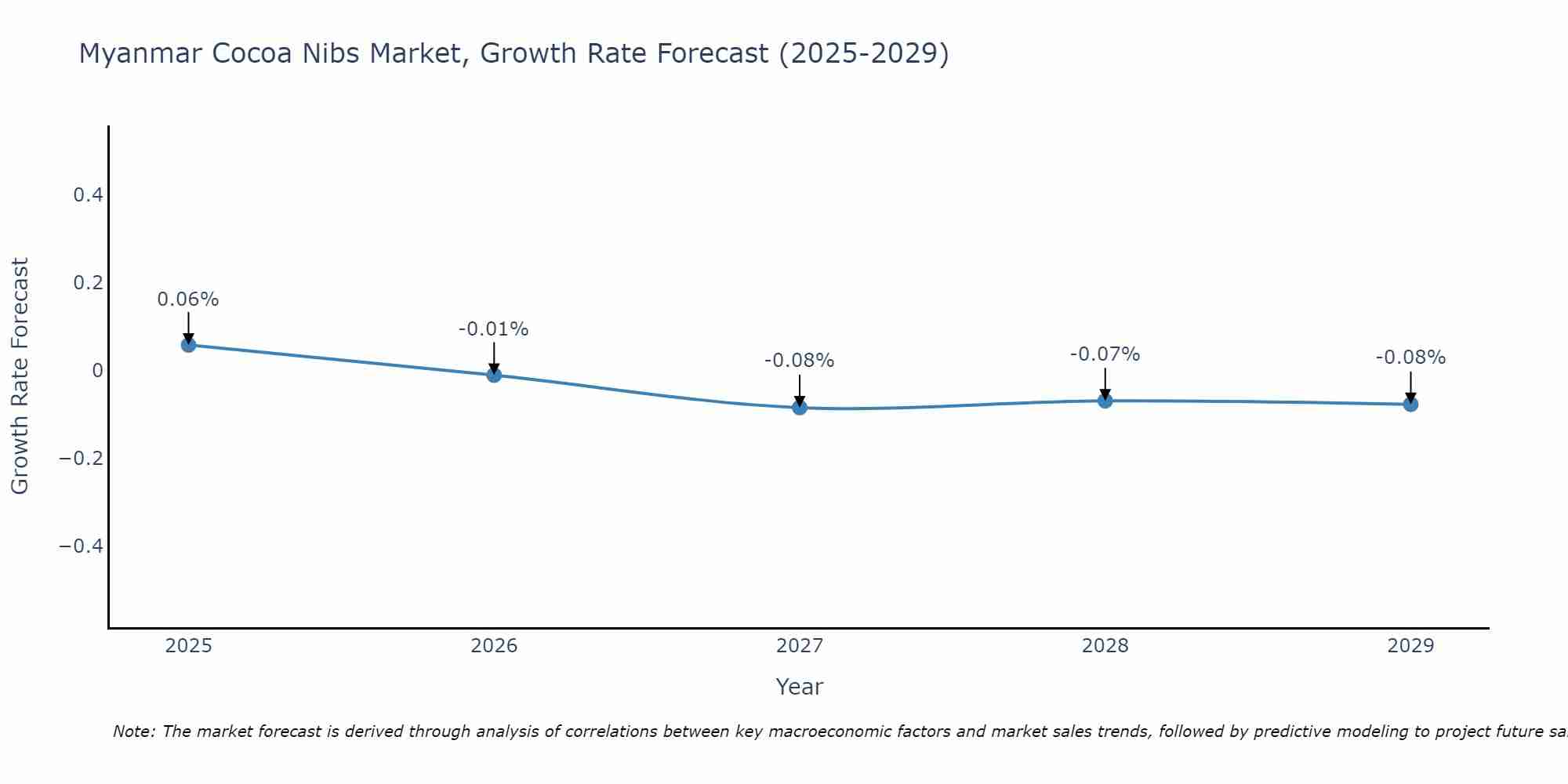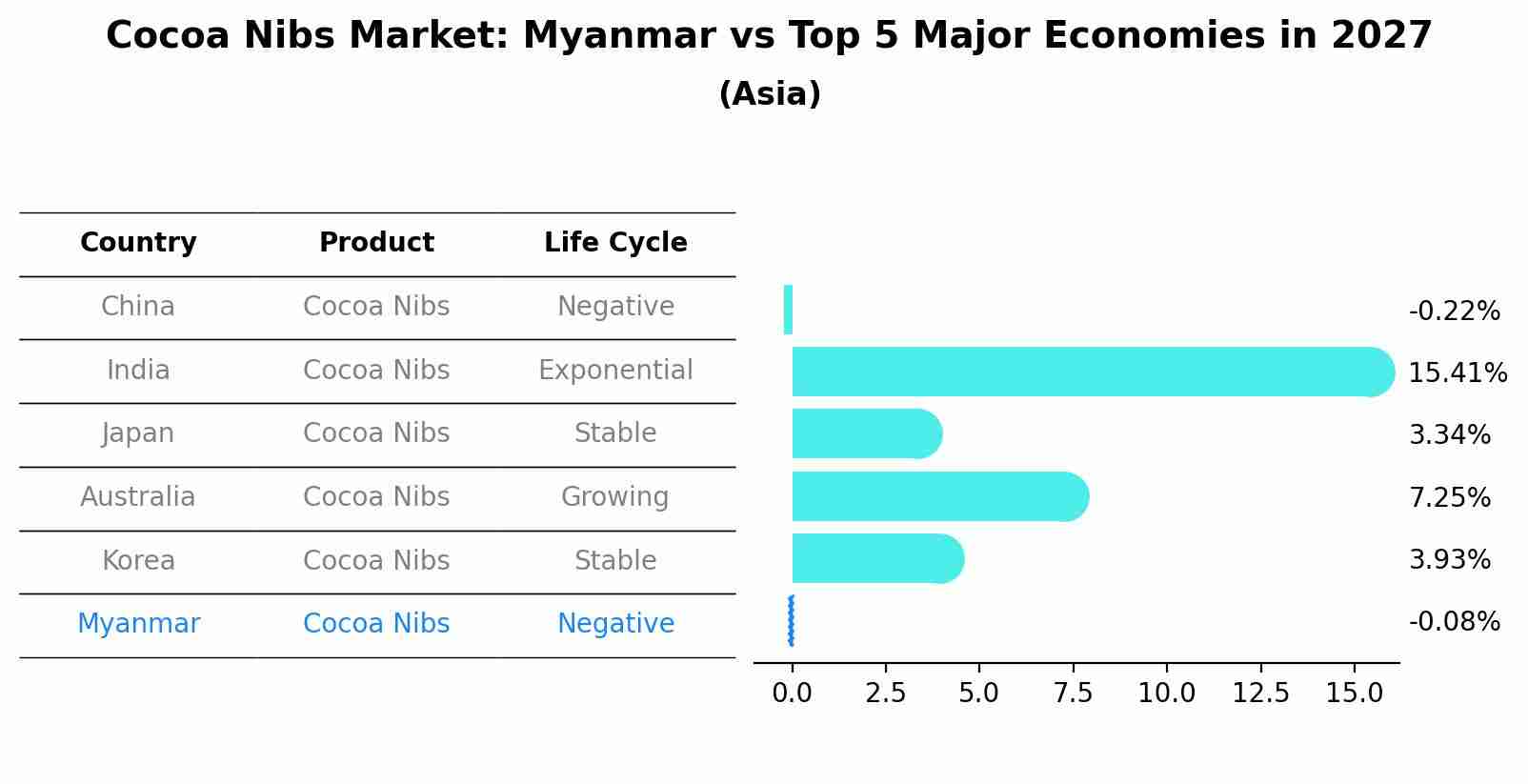Myanmar Cocoa Nibs Market (2025-2031) Outlook | Size, Forecast, Growth, Analysis, Revenue, Value, Share, Industry, Companies & Trends
| Product Code: ETC107273 | Publication Date: Jun 2021 | Updated Date: Jun 2025 | Product Type: Report | |
| Publisher: 6Wresearch | Author: Shubham Padhi | No. of Pages: 70 | No. of Figures: 35 | No. of Tables: 5 |
Myanmar Cocoa Nibs Market Size Growth Rate
The Myanmar Cocoa Nibs Market is projected to witness mixed growth rate patterns during 2025 to 2029. Starting high at 0.06% in 2025, the market steadily declines to -0.08% by 2029.

Cocoa Nibs Market: Myanmar vs Top 5 Major Economies in 2027 (Asia)
By 2027, Myanmar's Cocoa Nibs market is forecasted to achieve a negative growth rate of -0.08%, with China leading the Asia region, followed by India, Japan, Australia and South Korea.

Myanmar Cocoa Nibs Market Overview
The Myanmar cocoa nibs market is experiencing growth due to increasing demand for premium and organic cocoa products globally. As a relatively new player in the cocoa industry, Myanmar has been focusing on producing high-quality cocoa nibs that are well-received by chocolate manufacturers and health-conscious consumers. The country`s unique climate and fertile soil provide favorable conditions for cultivating cocoa beans, resulting in flavorful and aromatic nibs. With a rising trend towards healthy snacking and artisanal chocolate products, Myanmar cocoa nibs are gaining popularity for their rich taste and nutritional benefits. The market is poised for further expansion as Myanmar continues to improve its cocoa cultivation practices and strengthen its presence in the global cocoa supply chain.
Myanmar Cocoa Nibs Market Trends
The Myanmar cocoa nibs market is experiencing growth due to increasing consumer awareness of the health benefits of cocoa products. There is a rising demand for organic and sustainably sourced cocoa nibs, driven by a growing interest in ethically produced goods. The market is also witnessing a trend towards premiumization, with consumers willing to pay more for high-quality cocoa nibs with unique flavors and textures. Additionally, the popularity of cocoa nibs as an ingredient in various food and beverage products is driving market expansion. Key players in the Myanmar cocoa nibs market are focusing on product innovation and marketing strategies to capitalize on these trends and cater to the evolving preferences of consumers.
Myanmar Cocoa Nibs Market Challenges
The Myanmar Cocoa Nibs Market faces several challenges, including limited infrastructure for cocoa cultivation and processing, lack of technical expertise among farmers, inconsistent quality of cocoa beans, and limited access to international markets. Additionally, the industry suffers from inadequate post-harvest handling practices, resulting in lower quality cocoa nibs. The lack of government support, financial resources, and research and development initiatives further hinder the growth of the cocoa nibs market in Myanmar. Overcoming these challenges will require investments in infrastructure, training programs for farmers, quality control measures, market access improvement, and policy support to promote the development of a sustainable cocoa industry in the country.
Myanmar Cocoa Nibs Market Investment Opportunities
The Myanmar Cocoa Nibs Market presents promising investment opportunities due to the increasing global demand for cocoa-based products. With Myanmar`s favorable climate for cocoa cultivation and a growing focus on sustainable agriculture practices, investing in cocoa nibs production could be lucrative. The market is relatively untapped, offering room for growth and innovation. Furthermore, the rising trend of health-conscious consumers seeking natural and organic products positions cocoa nibs as a sought-after ingredient in the food and beverage industry. Investing in Myanmar`s cocoa nibs market could yield high returns by capitalizing on the country`s agricultural potential and the growing demand for premium cocoa products in both domestic and international markets.
Myanmar Cocoa Nibs Market Government Policy
The government policies related to the Myanmar Cocoa Nibs Market aim to promote sustainable growth and increase competitiveness in the industry. This includes initiatives to support cocoa farmers through training programs, providing access to financing, and promoting good agricultural practices to improve yield and quality. The government also focuses on enhancing infrastructure for cocoa processing facilities to meet international standards and increase export potential. Additionally, there are regulations in place to ensure fair trade practices and environmental sustainability in the cocoa industry. Overall, the government is working towards developing a vibrant and sustainable cocoa nibs market in Myanmar through a combination of support for farmers, investment in infrastructure, and regulatory frameworks to drive growth and competitiveness in the sector.
Myanmar Cocoa Nibs Market Future Outlook
The Myanmar cocoa nibs market is poised for growth in the coming years, driven by increasing consumer awareness of the health benefits of cocoa and a growing demand for premium chocolate products. As global interest in sustainable and ethically sourced cocoa products continues to rise, Myanmar`s cocoa industry stands to benefit from its unique position as a producer of high-quality cocoa beans. With a focus on improving farming practices and post-harvest processing techniques, Myanmar is likely to attract more attention from international buyers looking for unique flavor profiles and responsibly sourced cocoa products. Overall, the future outlook for the Myanmar cocoa nibs market appears promising, with opportunities for expansion and increased market share both domestically and internationally.
Key Highlights of the Report:
- Myanmar Cocoa Nibs Market Outlook
- Market Size of Myanmar Cocoa Nibs Market, 2021
- Forecast of Myanmar Cocoa Nibs Market, 2031
- Historical Data and Forecast of Myanmar Cocoa Nibs Revenues & Volume for the Period 2021 - 2031
- Myanmar Cocoa Nibs Market Trend Evolution
- Myanmar Cocoa Nibs Market Drivers and Challenges
- Myanmar Cocoa Nibs Price Trends
- Myanmar Cocoa Nibs Porter's Five Forces
- Myanmar Cocoa Nibs Industry Life Cycle
- Historical Data and Forecast of Myanmar Cocoa Nibs Market Revenues & Volume By Product for the Period 2021 - 2031
- Historical Data and Forecast of Myanmar Cocoa Nibs Market Revenues & Volume By Conventional for the Period 2021 - 2031
- Historical Data and Forecast of Myanmar Cocoa Nibs Market Revenues & Volume By Organic for the Period 2021 - 2031
- Historical Data and Forecast of Myanmar Cocoa Nibs Market Revenues & Volume By Application for the Period 2021 - 2031
- Historical Data and Forecast of Myanmar Cocoa Nibs Market Revenues & Volume By Commercial for the Period 2021 - 2031
- Historical Data and Forecast of Myanmar Cocoa Nibs Market Revenues & Volume By Household for the Period 2021 - 2031
- Myanmar Cocoa Nibs Import Export Trade Statistics
- Market Opportunity Assessment By Product
- Market Opportunity Assessment By Application
- Myanmar Cocoa Nibs Top Companies Market Share
- Myanmar Cocoa Nibs Competitive Benchmarking By Technical and Operational Parameters
- Myanmar Cocoa Nibs Company Profiles
- Myanmar Cocoa Nibs Key Strategic Recommendations
Frequently Asked Questions About the Market Study (FAQs):
1 Executive Summary |
2 Introduction |
2.1 Key Highlights of the Report |
2.2 Report Description |
2.3 Market Scope & Segmentation |
2.4 Research Methodology |
2.5 Assumptions |
3 Myanmar Cocoa Nibs Market Overview |
3.1 Myanmar Country Macro Economic Indicators |
3.2 Myanmar Cocoa Nibs Market Revenues & Volume, 2021 & 2031F |
3.3 Myanmar Cocoa Nibs Market - Industry Life Cycle |
3.4 Myanmar Cocoa Nibs Market - Porter's Five Forces |
3.5 Myanmar Cocoa Nibs Market Revenues & Volume Share, By Form, 2021 & 2031F |
3.6 Myanmar Cocoa Nibs Market Revenues & Volume Share, By Form, 2021 & 2031F |
4 Myanmar Cocoa Nibs Market Dynamics |
4.1 Impact Analysis |
4.2 Market Drivers |
4.3 Market Restraints |
5 Myanmar Cocoa Nibs Market Trends |
6 Myanmar Cocoa Nibs Market, By Types |
6.1 Myanmar Cocoa Nibs Market, By Product |
6.1.1 Overview and Analysis |
6.1.2 Myanmar Cocoa Nibs Market Revenues & Volume, By Product, 2018 - 2027F |
6.1.3 Myanmar Cocoa Nibs Market Revenues & Volume, By Conventional, 2018 - 2027F |
6.1.4 Myanmar Cocoa Nibs Market Revenues & Volume, By Organic, 2018 - 2027F |
6.2 Myanmar Cocoa Nibs Market, By Application |
6.2.1 Overview and Analysis |
6.2.2 Myanmar Cocoa Nibs Market Revenues & Volume, By Commercial, 2018 - 2027F |
6.2.3 Myanmar Cocoa Nibs Market Revenues & Volume, By Household, 2018 - 2027F |
7 Myanmar Cocoa Nibs Market Import-Export Trade Statistics |
7.1 Myanmar Cocoa Nibs Market Export to Major Countries |
7.2 Myanmar Cocoa Nibs Market Imports from Major Countries |
8 Myanmar Cocoa Nibs Market Key Performance Indicators |
9 Myanmar Cocoa Nibs Market - Opportunity Assessment |
9.1 Myanmar Cocoa Nibs Market Opportunity Assessment, By Product, 2021 & 2031F |
9.2 Myanmar Cocoa Nibs Market Opportunity Assessment, By Application, 2021 & 2031F |
10 Myanmar Cocoa Nibs Market - Competitive Landscape |
10.1 Myanmar Cocoa Nibs Market Revenue Share, By Companies, 2021 |
10.2 Myanmar Cocoa Nibs Market Competitive Benchmarking, By Operating and Technical Parameters |
11 Company Profiles |
12 Recommendations |
13 Disclaimer |
- Single User License$ 1,995
- Department License$ 2,400
- Site License$ 3,120
- Global License$ 3,795
Search
Thought Leadership and Analyst Meet
Our Clients
Related Reports
- Canada Oil and Gas Market (2026-2032) | Share, Segmentation, Value, Industry, Trends, Forecast, Analysis, Size & Revenue, Growth, Competitive Landscape, Outlook, Companies
- Germany Breakfast Food Market (2026-2032) | Industry, Share, Growth, Size, Companies, Value, Analysis, Revenue, Trends, Forecast & Outlook
- Australia Briquette Market (2025-2031) | Growth, Size, Revenue, Forecast, Analysis, Trends, Value, Share, Industry & Companies
- Vietnam System Integrator Market (2025-2031) | Size, Companies, Analysis, Industry, Value, Forecast, Growth, Trends, Revenue & Share
- ASEAN and Thailand Brain Health Supplements Market (2025-2031) | Strategy, Consumer Insights, Analysis, Investment Trends, Opportunities, Growth, Size, Share, Industry, Revenue, Segments, Value, Segmentation, Supply, Forecast, Restraints, Outlook, Competition, Drivers, Trends, Demand, Pricing Analysis, Competitive, Strategic Insights, Companies, Challenges
- ASEAN Bearings Market (2025-2031) | Strategy, Consumer Insights, Analysis, Investment Trends, Opportunities, Growth, Size, Share, Industry, Revenue, Segments, Value, Segmentation, Supply, Forecast, Restraints, Outlook, Competition, Drivers, Trends, Demand, Pricing Analysis, Competitive, Strategic Insights, Companies, Challenges
- Europe Flooring Market (2025-2031) | Outlook, Share, Industry, Trends, Forecast, Companies, Revenue, Size, Analysis, Growth & Value
- Saudi Arabia Manlift Market (2025-2031) | Outlook, Size, Growth, Trends, Companies, Industry, Revenue, Value, Share, Forecast & Analysis
- Uganda Excavator, Crane, and Wheel Loaders Market (2025-2031) | Strategy, Consumer Insights, Analysis, Investment Trends, Opportunities, Growth, Size, Share, Industry, Revenue, Segments, Value, Segmentation, Supply, Forecast, Restraints, Outlook, Competition, Drivers, Trends, Demand, Pricing Analysis, Competitive, Strategic Insights, Companies, Challenges
- Rwanda Excavator, Crane, and Wheel Loaders Market (2025-2031) | Strategy, Consumer Insights, Analysis, Investment Trends, Opportunities, Growth, Size, Share, Industry, Revenue, Segments, Value, Segmentation, Supply, Forecast, Restraints, Outlook, Competition, Drivers, Trends, Demand, Pricing Analysis, Competitive, Strategic Insights, Companies, Challenges
Industry Events and Analyst Meet
Whitepaper
- Middle East & Africa Commercial Security Market Click here to view more.
- Middle East & Africa Fire Safety Systems & Equipment Market Click here to view more.
- GCC Drone Market Click here to view more.
- Middle East Lighting Fixture Market Click here to view more.
- GCC Physical & Perimeter Security Market Click here to view more.
6WResearch In News
- Doha a strategic location for EV manufacturing hub: IPA Qatar
- Demand for luxury TVs surging in the GCC, says Samsung
- Empowering Growth: The Thriving Journey of Bangladesh’s Cable Industry
- Demand for luxury TVs surging in the GCC, says Samsung
- Video call with a traditional healer? Once unthinkable, it’s now common in South Africa
- Intelligent Buildings To Smooth GCC’s Path To Net Zero


















